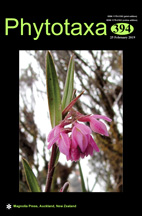Abstract
Based on cpDNA data, we provide the phylogenetic position for 18 species of Neotropical grammitid ferns (Polypodiaceae) that were not previously included in a molecular phylogeny. These species were resolved in Alansmia, Ceradenia, Enterosora, Grammitis, Lellingeria, Lomaphlebia, Melpomene, Moranopteris, Stenogrammitis, and Terpsichore. Our results indicate that Enterosora is polyphyletic and in need of generic recircumscription. We maintain the identity of Enterosora, based on the position of E. campbellii subsp. spongiosa, a variety of the type species. This finding allowed us to conclude that the E. parietina clade should be excluded from Enterosora. To accommodate this clade we describe a new genus, Parrisia. It is related to Adenophorus and a clade that includes Cochlidium, Grammitis s.s., and Lomaphlebia. We further found that Zygophlebia is paraphyletic with respect to Enterosora, represented by two separate clades, Zygophlebia s. s. that includes Z. cornuta, the type species, Z. sectifrons and Z. matthewsii, and a second clade that includes another seven species of Zygophlebia as well as E. barbatula. As a separate clade, this Zygophlebia species could be maintained. However, we prefer to sink both Zygophlebia clades into Enterosora. We propose ten novel combinations for Enterosora, by moving Zygophlebia with a confirmed phylogenetic position to Enterosora. It is possible that the remaining Zygophlebia species should also be treated as Enterosora, but further research is necessary.

